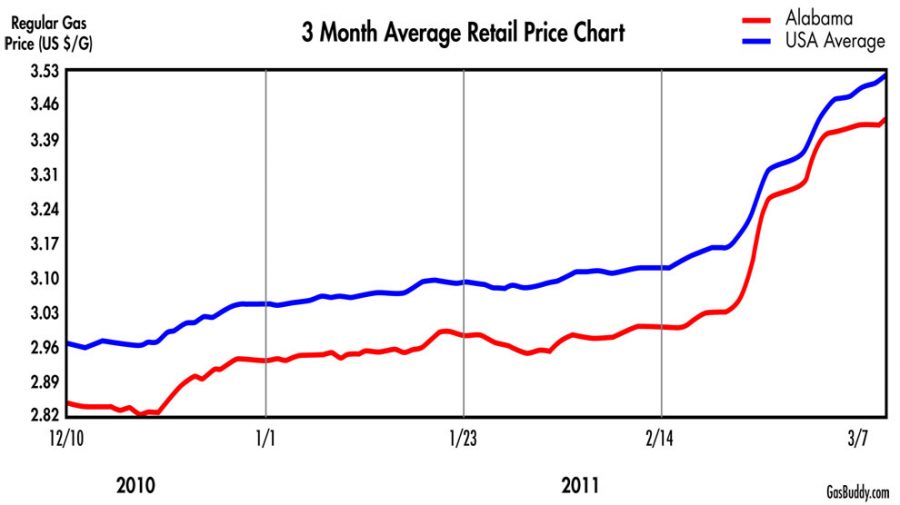This weekend, as students travel to the beach or other spring break destinations, one question is sure to come up at some time during the trip: What’s up with gas prices?
Compared to last year, gas prices have increased significantly. A year ago, the national average price of gas was nearly 77 cents cheaper per gallon, according to the American Automobile Association.
The price of gas in Tuscaloosa, at $3.42, is slightly less than the current national average per gallon, which is $3.52, according to AAA. This reflects a 40-cent price increase over the past month.
San Diego, Calif., residents pay more to fill their gas tanks than anyone else in the U.S., at an average $3.97 per gallon, according to a report by U.S. News and World Report. Aurora, Colo., has the nation’s cheapest fuel at an average $3.26 per gallon.
Unrest in Libya and other oil-producing nations is the biggest reason for the spike in gas prices, said James Cover, an economics professor at the University.
“My best guess is that the commodity markets are bidding up the price of gasoline because they believe that the political events in the Middle East might lead to an interruption in the supply of crude oil to world markets, and perhaps the shutdown of some gasoline refineries in the Middle East,” he said.
Students have differing ideas about who they believe is responsible for high gas prices.
“I think the entire situation in the Middle East with all the chaos there is scaring gas companies into raising their prices,” said Damien Christian, a freshman majoring in criminal justice.
Although students have a common disgust for high prices at the pump, many say they’re not sure who is responsible.
“I don’t know, I guess the government is responsible,” said Hannah Stephens, a freshman majoring in marine science. “I mean, all I can say is you can’t blame George Bush for this.”
High fuel prices are also affecting the way some students spend their spring break.
“High gas prices may affect me because I was planning to go to Tampa after [my] spring break trip, and I don’t know how much extra money [high gas prices] will cost,” Christian said.
To counter high prices at the pump, students may utilize modern technology to save money and improve gas mileage.
Popular iPhone apps such as GasBuddy and FuelFinder use the phone’s GPS locator to find the cheapest gas prices in the vicinity. Still, the price of gas from station to station usually only fluctuates by a few pennies, making savings minimal.
The best ways to improve gas mileage are to drive responsibly and keep vehicles properly maintained, the AAA website states.
“As you drive faster, aerodynamic drag increases. At speeds above 55 mph, fuel economy drops rapidly,” the website states.
Students should also check to ensure that tires are properly inflated. Under-inflated tires can reduce fuel economy by 2 percent for each pound of pressure under the recommended level, according to the website.








